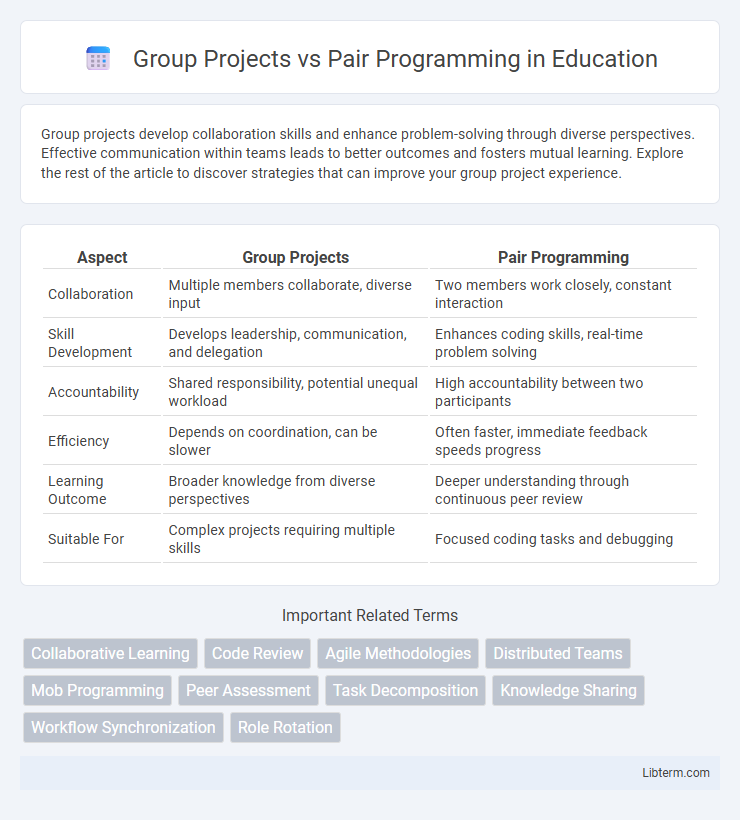Group projects develop collaboration skills and enhance problem-solving through diverse perspectives. Effective communication within teams leads to better outcomes and fosters mutual learning. Explore the rest of the article to discover strategies that can improve your group project experience.
Table of Comparison
| Aspect | Group Projects | Pair Programming |
|---|---|---|
| Collaboration | Multiple members collaborate, diverse input | Two members work closely, constant interaction |
| Skill Development | Develops leadership, communication, and delegation | Enhances coding skills, real-time problem solving |
| Accountability | Shared responsibility, potential unequal workload | High accountability between two participants |
| Efficiency | Depends on coordination, can be slower | Often faster, immediate feedback speeds progress |
| Learning Outcome | Broader knowledge from diverse perspectives | Deeper understanding through continuous peer review |
| Suitable For | Complex projects requiring multiple skills | Focused coding tasks and debugging |
Introduction to Collaborative Coding
Collaborative coding methods like group projects and pair programming enhance software development through teamwork and shared problem-solving. Group projects involve multiple members contributing various components, promoting diverse skill utilization and coordinated project management. Pair programming pairs two developers to write code simultaneously, improving code quality through continuous peer review and real-time knowledge exchange.
Defining Group Projects
Group projects involve multiple participants collaborating to achieve a shared goal, distributing tasks based on individual strengths and roles. These projects emphasize coordination, communication, and collective problem-solving over extended periods, often resulting in a comprehensive final product. Effective group projects balance workload and integrate diverse skills, fostering teamwork and project management skills.
What is Pair Programming?
Pair programming is a collaborative software development technique where two developers work together at a single workstation, continuously reviewing each other's code in real-time. This practice enhances code quality, improves problem-solving efficiency, and facilitates knowledge sharing between team members. By engaging in constant communication and immediate feedback, pair programming reduces bugs and accelerates learning compared to traditional group projects.
Key Differences Between Group Projects and Pair Programming
Group projects typically involve multiple team members collaborating on a complex task, distributing responsibilities across diverse roles to leverage varied expertise, while pair programming consists of two developers working closely on the same codebase in real-time to enhance code quality and immediate problem-solving. Group projects often face challenges in coordination, communication, and integration of work, whereas pair programming promotes continuous code review, faster debugging, and shared knowledge through direct interaction. The key difference lies in the scope and collaboration intensity: group projects emphasize parallel task execution among several people, whereas pair programming focuses on synchronous collaboration between two programmers for immediate feedback and improved code accuracy.
Advantages of Group Projects
Group projects promote diverse perspectives and collaborative problem-solving, enhancing creativity and innovation through the pooling of varied skills and knowledge. They enable the distribution of tasks according to individual strengths, increasing efficiency and allowing for the completion of more complex assignments. Furthermore, group projects foster essential interpersonal skills such as communication, teamwork, and conflict resolution, which are valuable in both academic and professional settings.
Benefits of Pair Programming
Pair programming significantly enhances code quality through continuous peer review, leading to fewer bugs and improved design decisions. It fosters real-time knowledge sharing and skill development, accelerating the onboarding process for new team members. Collaboration in pair programming also boosts communication and teamwork, resulting in more efficient problem-solving compared to group projects.
Common Challenges Faced in Group Projects
Group projects often encounter challenges such as communication breakdowns, uneven workload distribution, and conflicting schedules among team members. Difficulty in aligning goals and varying levels of commitment can lead to delays and decreased overall productivity. Managing diverse skill sets while ensuring effective collaboration remains a persistent hurdle in group project environments.
Typical Obstacles in Pair Programming
Typical obstacles in pair programming include communication barriers, mismatched skill levels, and differing work styles, which can hinder productivity and collaboration. Conflicts may arise when partners struggle to synchronize their thought processes or coding approaches, leading to frustration and decreased efficiency. Time management challenges also occur as pairs must coordinate schedules and maintain a consistent workflow to avoid delays in project completion.
When to Choose Group Projects Over Pair Programming
Group projects excel when diverse skill sets and multiple perspectives are essential to tackle complex, multidisciplinary problems. Large-scale tasks requiring parallel workflows and resource sharing benefit from collaboration among several team members. Opt for group projects when fostering communication skills, leadership, and collective problem-solving is a priority over the close collaboration focus inherent in pair programming.
Best Practices for Effective Collaborative Coding
Effective collaborative coding requires clear role assignments and consistent communication in both group projects and pair programming. Utilizing version control systems like Git ensures seamless code integration and conflict resolution during teamwork. Regular code reviews and continuous feedback loops enhance code quality, foster knowledge sharing, and accelerate problem-solving for all collaborators.
Group Projects Infographic

 libterm.com
libterm.com